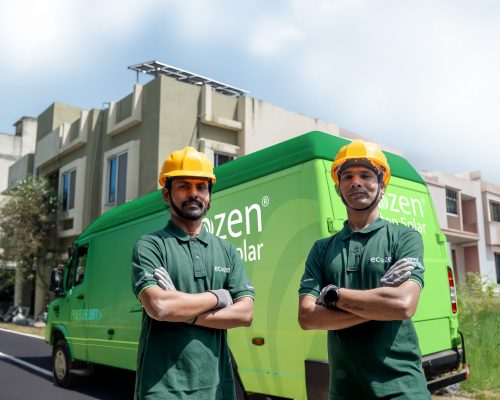The PM Surya Ghar Muft Bijli Yojana is steadily reshaping India’s rooftop solar landscape. What began as a flagship policy announcement is now moving into execution, with thousands of households registering across the country.
For Uttar Pradesh (UP) — India’s most populous state — this scheme could spark nothing less than an energy transformation.
Why Rooftop Solar Matters in India
India has long recognised rooftop solar as a pillar of its clean energy mission. But progress has often lagged behind ambition.
Reality check:
- Target for 2020: 10 GW rooftop solar
- Achievement: barely 5 GW
Reasons adoption slowed:
- Limited consumer awareness
- Inconsistent execution by local dealers
- Weak after-sales support
At Ecozen, we’ve seen this first-hand. With 4 lakh+ decentralised solar systems deployed in the past 15 years, we know adoption succeeds only when three things come together: quality technology, reliable execution, and long-term service.
What PM Surya Ghar Brings to the Table
The scheme focuses on what truly matters to households:
- Simple subsidy flows
- Reliable vendor platforms
- Strong monitoring for peace of mind
For UP’s 23 crore people and 4 crore households, the potential is enormous.
If even one in four homes installs rooftop solar, that’s 1 crore rooftops — enough to reshape India’s decentralised energy capacity.
What Households Stand to Gain
- Average UP household spend: ₹2,000/month (~₹24,000 annually)
- Subsidy under PM Surya Ghar: ₹30,000 – ₹78,000
- Annual savings: ₹18,000–₹24,000
- Lifetime savings (20 years): several lakh rupees
If just 10 lakh households adopt, the collective saving = ₹2,400 crore every year.
Momentum on the Ground
UP is already showing strong traction:
- Q2 2025: Rooftop solar installations in UP grew 19% — above the national average
For a state long associated with power cuts, this surge proves: households are ready for solar if delivered with reliability.
Global Lessons for Uttar Pradesh
- Germany: 2.5 million solar rooftops (despite limited sunshine)
- Australia: 30% household penetration
With abundant solar irradiation and a vast household base, UP can leapfrog these benchmarks.
The Gaps That Still Remain
Current Surya Ghar systems are on-grid only.
They reduce bills but don’t provide backup during outages — still a challenge in many UP towns.
This is where Ecozen’s experience matters. Across pumps, cold rooms, solar ACs, and solar atta chakkis, we’ve learned:
“Adoption doesn’t end with installation. Without strong after-sales support and local servicing, systems risk underperforming.”
For Surya Ghar to succeed, subsidy must be matched with execution quality, maintenance, and trust at scale.
A Family’s Solar Story in UP
Take a middle-class family in Lucknow paying ₹2,000 monthly on electricity.
- With rooftop solar, their ₹24,000 annual burden drops significantly
- Over 20 years, the savings could fund a child’s college education or cushion rising living costs
Multiply this by 1 million households, and the impact becomes a statewide economic dividend.
Environmental & Economic Gains
Climate impact:
- Every kW of rooftop solar offsets 1.5 tonnes of CO₂ annually
- 1 crore rooftops in UP = 15–20 million tonnes CO₂ cut each year
- Equivalent to removing millions of cars from Indian roads
Jobs impact:
- Thousands of roles in installation, servicing, and manufacturing
- Embedding solar deeper into UP’s economy
Ecozen’s Perspective
As Ecozen’s 15-year journey shows:
“The future belongs not to those who install the fastest, but those who build the most trust.”
For UP, this is about more than lower bills. It’s about:
- Energy dignity
- Households as producers of clean power, not just consumers
- A sustainable path that benefits families, economy, and planet
Final Word
The sun has always been UP’s constant companion.
Now, with 1 crore rooftops, it can become the state’s most powerful ally.




